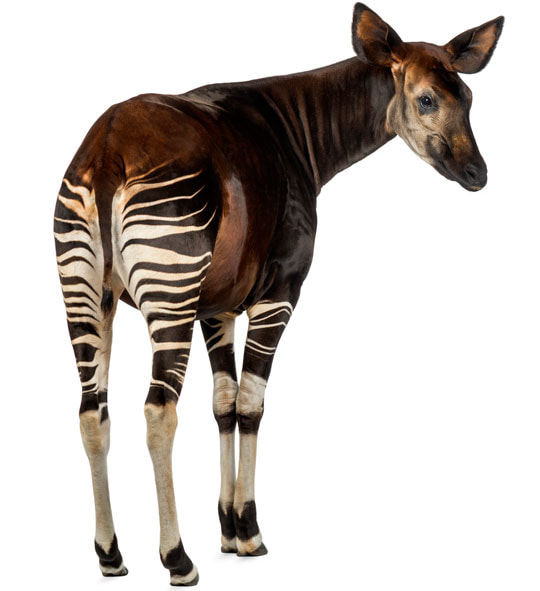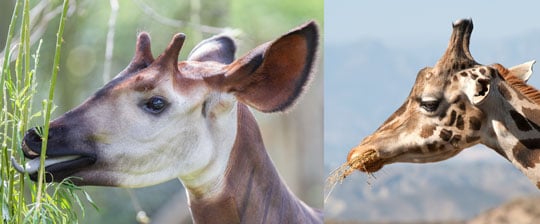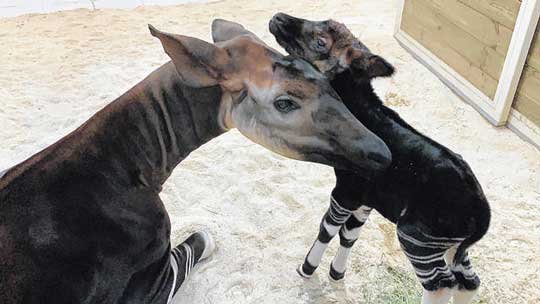|
Imagine an animal that appears to be part zebra, part giraffe, and part donkey. Your imaginary creature might look something like an okapi. In fact, the okapi is sometimes called the zebra giraffe. In spite of its large size and distinct appearance, the okapi was not announced and described by western scientists until early in the 20th century. Why? Because they are reclusive and live only in the lowland forests of the Democratic Republic of Congo (in central Africa). What the heck is an Okapi? The okapi (pronounced oh-COP-ee) is not closely related to zebras. If you look at an okapi's head, you'll see that the general structure is similar to the head of a giraffe. In fact, okapis are the only living close relative of giraffes (in the family Giraffidae). In addition to the name zebra giraffe, it is also called the forest giraffe. The okapi is an artiodactyl mammal (an ungulate that stands on two of its toes). They weigh from 440 to 770 pounds (200 to 350 kg) and stand about 5 feet (1.5 m) tall at the shoulder. Unfortunately, they are endangered, and their numbers have been reduced by half in the last 15 years. Below you can see the resemblance between an okapi's head and a giraffe's head. Amazing Facts about the Okapi Did you notice the okapi in the first photo above does not have horns, but the one in the second photo does? That's because the first one is a female and the second is a male. Giraffes have these also. These short little horns are actually called ossicones. The weird thing is, only male okapis have ossicones, but both female and male giraffes have ossicones! Hmmm. What's up with that? Have you ever watched a giraffe walk? Okapis and giraffes have a strange gait called a pacing gait--they step with both of the legs on one side of the body at the same time. So, they step forward with both the right legs, then step with both the left legs. All other ungulates walk by stepping forward with alternate legs on either side of the body. I know... it's hard to picture, isn't it? Check out this video of a giraffe's pacing gait. Like giraffes, okapis have ridiculously long tongues. An okapi's tongue is 18 inches (46 cm) long! These creatures feed on understory plants in the forest, and this long tongue helps them select and pull off their favorite types of leaves. Also, the tongue is so long that they can use it to clean their eyes and even their ears. Below is an okapi grooming itself with its tongue. The okapi keeps this long tongue busy by eating all day. In fact, they eat up to 60 pounds (27 kg) of plant material every day. They must not be too picky, because they have been observed eating over 100 different types of plants, some of which are poisonous to humans and other animals. They eat clay from the riverbeds to replenish salt and minerals. They also eat charred wood from trees that have been struck by lightning (again, probably to get minerals). And, as if that weren't strange enough, okapis even snarf up bat excrement. Yummy. Check out this video about Okapis Okapis live most of their lives alone, although occasionally they will gather in groups to eat, to groom each other, and to play. What about those weird, zebra-like stripes on their legs and rump? These may help camouflage the okapi in its forest habitat (leopards are a natural predator of okapis). My favorite explanation, though, is that these are the okapi's "follow-me stripes." Some people believe the stripes help baby okapis see and follow the adults through the dense forest. Hmm... these seem to me to be contradictory explanations—one says the stripes hide the okapi, one says the stripes make the okapi more visible. Which do you think it is? Okapis typically give birth to only one calf per breeding season. The calves are vulnerable to predation, so it helps that they can get up on their feet and start walking around within 30 minutes after being born. Here's an even more fascinating way the young avoid predators: okapi calves cannot poop until they are a month old. Why? This eliminates the possibility of the smell of young okapi feces attracting predators. At this moment, I'm trying not to visualize an okapi calf pooping after holding it in for a month. Mother okapis communicate with their calves by making infrasonic sounds, which humans and some other animals can't hear. What is an infrasonic sound, you ask? Well, you've heard of ultrasonic sounds. Those are high-frequency sounds (frequencies above 20kHz). Infrasonic sounds have frequencies below 20Hz. So, ultrasonic is too high for humans to hear, infrasonic is too low for us to hear. Guess what... leopards cannot hear infrasonic sounds either. Cool, huh? So, the Okapi deserves a place in the K.A.H.O.F. (Knockout Animal Hall of Fame). FUN FACT: The word knockout, originated in 1887, and it was used in reference to boxing, meaning "to stun by a blow for a 10-count." In 1892, people decided to expand the use of the word to also describe an "excellent thing or person." It wasn't until 1953 that it became a common way to describe a beautiful woman. Interestingly, starting in 1936, knock yourself out became a way to tell someone to "make a great effort." Anyway, because knockout is used to describe someone or something as "excellent," it is another way to say awesome! Photo Credits:
Black and rufous elephant shrew - DepositPhotos Dog noses - DepositPhotos Freddy Mercury and cat - AllThatsInteresting Crow on the street with walnut - CrowBehavior Okapi on white background - DepositPhotos Okapi head closeup - DepositPhotos Giraffe head closeup - DepositPhotos Okapi tongue - kaelin, CC BY-SA 2.0 via Wikimedia Commons Okapi from behind, with forest as background - DepositPhotos Okapi with calf - Columbus Zoo
0 Comments
Leave a Reply. |
Stan's Cogitations
Everyone needs a creative outlet. That's why I write. Archives
July 2024
|






 RSS Feed
RSS Feed